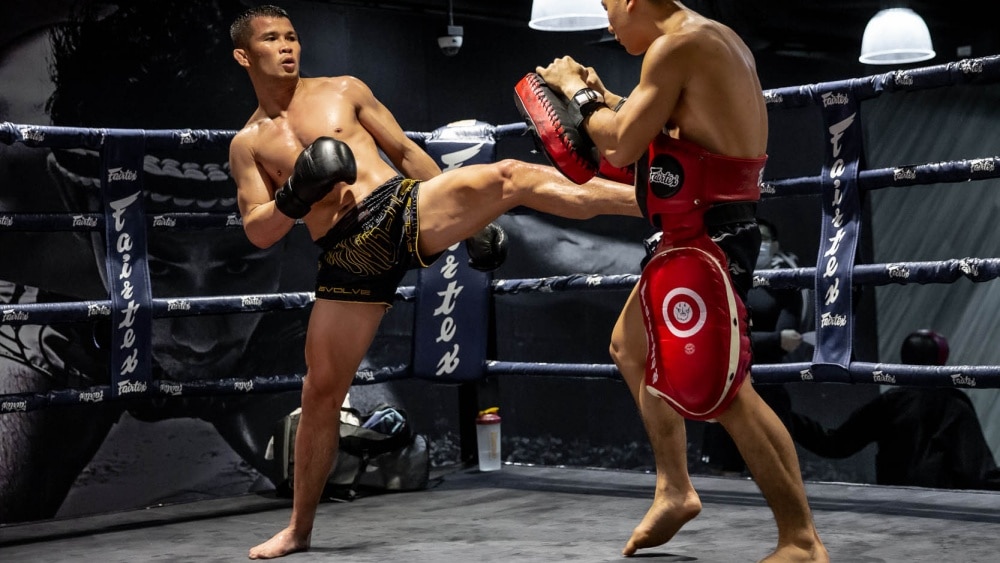8 Boxing And Muay Thai Techniques For Self-Defense

Guest post by Evolve MMA, Asia’s premier championship brand for martial arts. It has the most number of World Champions on the planet. Named as the #1 ranked martial arts organization in Asia by CNN, Yahoo! Sports, FOX Sports, Evolve MMA is the top rated Muay Thai gym in Singapore.
Everyone should have the ability to defend themselves. In the event an altercation turns physical, having trained in some form of self-defense can be a lifesaver. Most altercation starts from a standing position, hence it’s important for you to know how to properly defend yourself using techniques from two of the most effective striking arts; boxing and Muay Thai.
Boxing
When most people think of a street fight, images of fists flying come to mind. There is a good reason for that. A punch is one of the most common types of attacks thrown once an altercation turns physical. Training boxing techniques can help end altercations quickly and avoid further injury to all parties involved.
A) Stance
Boxing as a southpaw can give you an advantage in the ring and that advantage remains in a real-life altercation. Even if your attacker has previously trained themselves, the odds of them knowing how to effectively deal with a skilled southpaw are next to none. This is due to the overwhelming number of orthodox (right-handed) fighters compared to southpaws. The other reason is due to you and your attacker being in an open stance instead of the usual closed stance formed by two orthodox fighters.
B) Jab
The jab is the most important punch in boxing, and it may be the most important in a street fight too. It is the punch that exposes the least amount of your body and head for a counter, as well as being your weapon with the most range. Your jab is performed with your lead hand and should be sharp and snappy. When starting out, don’t focus on adding power to your punch, the power will naturally increase as your form develops.
C) Footwork
Quick footwork compliments an educated jab and exponentially increases its effectiveness. Two techniques that can translate to a self-defense setting are the gazelle and pendulum steps. The gazelle step involves you loading your weight onto your lead leg, stepping up with your rear leg, then explosively shuffling forwards. This technique can cover massive distances and adds tremendous amounts of power when used in conjunction with a punch.
D) Parry
Parrying is a boxing technique that is essential for self-defense. It can be done on both your lead and rear side, and in general works best for defending against straight punches. When your opponent throws a punch, you parry on the same side. Catch their fist like a baseball and pat it slightly downwards. This will give you the opportunity to either land your own punch or run.
The art of eight limbs has much to offer when it comes to self-defense.
A) Teep (Push Kick)
The first Muay Thai technique for self-defense is the teep, or push kick. It is often called the foot jab, and just like the jab in boxing, the teep is one of, if not the most important kick in Muay Thai. Muay Thai legend Samart Payakaroon breaks down the proper form of a teep above.
The teep, although usually performed by the front leg, can also be done with the rear leg for a powerful kick that will stop your opponent’s momentum. You can aim the teep at various targets on your opponent’s body. Some of the most effective are the knees, the hips, the solar plexus, and the navel. Although head kicks are possible, they are best avoided in a self-defense situation. It is generally not worth the risk of being thrown on the concrete, even if there is an opening. Self-defense situations do not have the rules that a ring does and impact with the concrete floor is a dangerous variable.
B) Up Elbow
Another powerful weapon that Muay Thai can offer is the elbow strike. Your elbows are the densest bones in your body and exponentially multiply force due to the small surface area that you strike with. Since they have an extremely limited range, they are best used when you or your attacker are in range to grab each other.
The up elbow is effective because it blocks your opponent’s punch as they run into your elbow strike. To perform an up elbow, place your lead palm on the side of your forehead while you step in towards your attacker. Drive the point of your elbow into their shoulder or bicep to jam their punch, or aim for the chin or nose to stun them.
C) Horizontal Elbow
The horizontal elbow can be used anytime you are in clinch range and should be aimed at the chin, temple, or ear of your opponent for the best chances to knockout your attacker. To perform a horizontal elbow, lift your elbow and smash it into your attacker’s chin while bridging the back of your hand to touch the opposite side shoulder.
D) Spinning Back Elbow
The spinning back elbow may look flashy, but it has many practical applications as well. An altercation outside of the gym may involve multiple people who attack from all sides. Most techniques used in boxing and Muay Thai are effective under the premise that the fight is a fair one. The spinning back elbow is one of the few techniques that can address the threat of multiple attackers. Although every technique has its place, spinning during a fight is generally a poor choice. That is unless it is done with specific intent. Training the spinning back elbow lets you strike opponents that are behind you directly after defending or countering the attack of someone in front of you. In addition, you can even shoulder bump an opponent’s punch so they lose balance and fall into your elbow, which would most likely result in a knockout.
There Is More
These techniques are just the tip of the iceberg when it comes to self-defense. However, they can give you the edge to defend yourself should the need arise. Remember that self-defense is not about flashy knockouts or highlight-reel submissions, it’s a fight to live another day. If you are looking to learn self-defense from martial arts World Champions, sign up for a complimentary trial class today!






